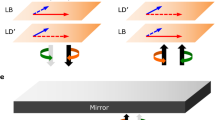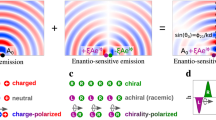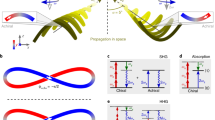Abstract
Detecting and quantifying chirality is important in fields ranging from analytical and biological chemistry to pharmacology1 and fundamental physics2: it can aid drug design and synthesis, contribute to protein structure determination, and help detect parity violation of the weak force. Recent developments employ microwaves3, femtosecond pulses4, superchiral light5 or photoionization6 to determine chirality, yet the most widely used methods remain the traditional methods of measuring circular dichroism and optical rotation. However, these signals are typically very weak against larger time-dependent backgrounds7. Cavity-enhanced optical methods can be used to amplify weak signals by passing them repeatedly through an optical cavity, and two-mirror cavities achieving up to 105 cavity passes have enabled absorption and birefringence measurements with record sensitivities8,9,10. But chiral signals cancel when passing back and forth through a cavity, while the ubiquitous spurious linear birefringence background is enhanced. Even when intracavity optics overcome these problems11,12,13,14,15, absolute chirality measurements remain difficult and sometimes impossible. Here we use a pulsed-laser bowtie cavity ringdown polarimeter with counter-propagating beams16,17 to enhance chiral signals by a factor equal to the number of cavity passes (typically >103); to suppress the effects of linear birefringence by means of a large induced intracavity Faraday rotation; and to effect rapid signal reversals by reversing the Faraday rotation and subtracting signals from the counter-propagating beams. These features allow absolute chiral signal measurements in environments where background subtraction is not feasible: we determine optical rotation from α-pinene vapour in open air, and from maltodextrin and fructose solutions in the evanescent wave produced by total internal reflection at a prism surface. The limits of the present polarimeter, when using a continuous-wave laser locked to a stable, high-finesse cavity, should match the sensitivity of linear birefringence measurements8 (3 × 10−13 radians), which is several orders of magnitude more sensitive than current chiral detection limits7,14,15 and is expected to transform chiral sensing in many fields.
This is a preview of subscription content, access via your institution
Access options
Subscribe to this journal
Receive 51 print issues and online access
$199.00 per year
only $3.90 per issue
Buy this article
- Purchase on Springer Link
- Instant access to full article PDF
Prices may be subject to local taxes which are calculated during checkout




Similar content being viewed by others
References
Berova, N., Polavarapu, P. L., Nakanishi, K. & Woody, W. (eds) Comprehensive Chiroptical Spectroscopy Vols 1 2 (Wiley, 2012)
Bouchiat, M. A. & Bouchiat, C. Parity violation in atoms. Rep. Prog. Phys. 60, 1351–1396 (1997)
Patterson, D., Schnell, M. & Doyle, J. M. Enantiomer-specific detection of chiral molecules via microwave spectroscopy. Nature 497, 475–477 (2013)
Rhee, H. J. et al. Femtosecond characterization of vibrational optical activity of chiral molecules. Nature 458, 310–313 (2009)
Tang, Y. Q. & Cohen, A. E. Enhanced enantioselectivity in excitation of chiral molecules by superchiral light. Science 332, 333–336 (2011)
Janssen, M. H. M. & Powis, I. Detecting chirality in molecules by imaging photoelectron circular dichroism. Phys. Chem. Chem. Phys. 16, 856–871 (2014)
Busch K. W., Busch M. A., eds. Chiral Analysis (Elsevier, 2006)
Durand, M., Morville, J. & Romanini, D. Shot-noise-limited measurement of sub-parts-per-trillion birefringence phase shift in a high-finesse cavity. Phys. Rev. A 82, 031803 (2010)
Berden, G., Peeters, R. & Meijer, G. Cavity ring-down spectroscopy: experimental schemes and applications. Int. Rev. Phys. Chem. 19, 565–607 (2000)
Engeln, R., Berden, G., Peeters, R. & Meijer, G. Cavity enhanced absorption and cavity enhanced magnetic rotation spectroscopy. Rev. Sci. Instrum. 69, 3763–3769 (1998)
Evtuhov, V. & Siegman, A. E. A. “Twisted-mode” technique for obtaining axially uniform energy density in a laser cavity. Appl. Opt. 4, 142–143 (1965)
Kastler, A. Champ lumineux stationnaire à structure hélicoïdale dans une cavité laser. C. R. Acad. Sci. Paris B 271, 999–1001 (1970)
Poirson, J., Vallet, M., Bretenaker, F., Le Floch, A. & Thepot, J. Resonant cavity gas-phase polarimeter. Anal. Chem. 70, 4636–4639 (1998)
Müller, T., Wiberg, K. B. & Vaccaro, P. H. Cavity ring-down polarimetry (CRDP): a new scheme for probing circular birefringence and circular dichroism in the gas phase. J. Phys. Chem. A 104, 5959–5968 (2000)
Wilson, S. M., Wiberg, K. B., Cheeseman, J., Frisch, M. J. & Vaccaro, P. Nonresonant optical activity of isolated organic molecules. J. Phys. Chem. A 109, 11752–11764 (2005)
Bougas, B., Katsoprinakis, G. E., von Klitzing, W., Sapirstein, J. & Rakitzis, T. P. Cavity-enhanced parity-nonconserving optical rotation in metastable Xe and Hg. Phys. Rev. Lett. 108, 210801 (2012)
Bougas, B., Katsoprinakis, G. E., von Klitzing, W. & Rakitzis, T. P. Fundamentals of cavity-enhanced polarimetry for parity-nonconserving optical rotation measurements: application to Xe, Hg and I. Phys. Rev. A 89, 052127 (2014)
Condon, E. U. Theories of optical rotatory power. Rev. Mod. Phys. 9, 432–457 (1937)
Silverman, M. P. Reflection and refraction at the surface of a chiral medium: comparison of gyrotropic constitutive relations invariant or noninvariant under a duality transformation. J. Opt. Soc. Am. A 3, 830–837 (1986)
Lekner, J. Optical properties of isotropic chiral media. Pure Appl. Opt. 5, 417–443 (1996)
Goos, F. & Hänchen, H. Ein neuer und fundamentaler Versuch zur Totalreflexion. Ann. Phys. 436, 333–346 (1947)
Emile, J. et al. Giant optical activity of sugar in thin soap films. J. Coll. Inter. Sci. 408, 113–116 (2013)
Acknowledgements
This research was supported by the ERC grant TRICEPS (grant no. 207542), and the FP7 IAPP Programme SOFORT (PIAPGA-2009-251598). B.L. acknowledges the FP7 Infrastructure programme ESMI (CP&CSA-2010-262348) for partial support. We thank P. Tzallas for access to the Attosecond labs at IESL-FORTH.
Author information
Authors and Affiliations
Contributions
L.B. constructed the experiment, performed the gas-cell and open-air experiments, and analysed the data. D.S. performed the evanescent-wave experiments and analysed the data. G.E.K. and A.K.S. developed the data acquisition and analysis software, and assisted in the experiments. G.E.K. prepared the figures. B.L. derived the evanescent-wave optical rotation equations. T.P.R. had the idea for and directed the experiments, and wrote the manuscript. All authors provided important suggestions for the experiments, discussed the results and contributed to the manuscript.
Corresponding author
Ethics declarations
Competing interests
The authors declare no competing financial interests.
Rights and permissions
About this article
Cite this article
Sofikitis, D., Bougas, L., Katsoprinakis, G. et al. Evanescent-wave and ambient chiral sensing by signal-reversing cavity ringdown polarimetry. Nature 514, 76–79 (2014). https://doi.org/10.1038/nature13680
Received:
Accepted:
Published:
Issue Date:
DOI: https://doi.org/10.1038/nature13680
This article is cited by
-
Effects of dual cross Kerr non-linearity on the manipulation of rotary photon drag
Optical and Quantum Electronics (2023)
-
Assignment-free chirality detection in unknown samples via microwave three-wave mixing
Communications Chemistry (2022)
-
Morphogenesis and Optoelectronic Properties of Supramolecular Assemblies of Chiral Perylene Diimides in a Binary Solvent System
Scientific Reports (2017)
-
Numerical model for predicting experimental effects in enantioselective Raman spectroscopy
Applied Physics B (2017)
-
Cavity ring-down Faraday rotation spectroscopy for oxygen detection
Applied Physics B (2017)
Comments
By submitting a comment you agree to abide by our Terms and Community Guidelines. If you find something abusive or that does not comply with our terms or guidelines please flag it as inappropriate.



